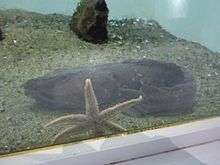Lycodes
Lycodes is a genus of zoarcid fish in the subfamily Lycodinae.[1][2] It is the most species-rich genus in its taxonomic family as well as in the Arctic Ocean and adjacent waters. They occupy both shallow waters and deeper waters down to 3000 meters. A few species can occur in brackish waters.[3]
| Lycodes | |
|---|---|
 | |
| Lycodes turneri | |
 | |
| Lycodes vahlii | |
| Scientific classification | |
| Kingdom: | |
| Phylum: | |
| Class: | |
| Order: | |
| Family: | |
| Subfamily: | Lycodinae |
| Genus: | Lycodes J. C. H. Reinhardt, 1831[1] |
Description
The genus is characterized by one autapomorphy: submental crests, the more or less pronounced cartilage extensions on the lower jaws. Within the genus, one clade has been identified, the "short-tailed" Lycodes that are associated with shallower depths (0–1200 m) than the long-tailed species (3–3000 m). Short tail might represent an adaptation to shallow, Arctic waters; the clade includes many Arctic endemics. In contrast, the long-tailed species do not form a monophyletic group. Coloration of all short-tailed Lycodes includes some sorts of stripes, marks, or reticulations, while the long-tailed species are uniformly brownish, striped, or spotted.[3]
Ecology
Lycodes are bottom-dwelling fish with a relatively stationary life style. The eggs are benthic, few in number (<2000) and large in size (as large as 10 mm (0.4 in)).[3]
Species

Currently, 64 species are placed in this genus:[2]
- Lycodes adolfi J. G. Nielsen & Fosså, 1993 (Adolf's eelpout)
- Lycodes akuugun D. E. Stevenson & J. W. Orr, 2006
- Lycodes albolineatus Andriashev, 1955 (whitebar eelpout)
- Lycodes albonotatus (Taranetz & Andriashev, 1934)
- Lycodes bathybius P. Y. Schmidt, 1950
- Lycodes beringi Andriashev, 1935 (Bering eelpout)
- Lycodes brevipes T. H. Bean, 1890 (shortfin eelpout)
- Lycodes brunneofasciatus Suvorov, 1935 (tawnystripe eelpout)
- Lycodes caudimaculatus Matsubara, 1936
- Lycodes concolor T. N. Gill & Townsend, 1897 (ebony eelpout)
- Lycodes cortezianus (C. H. Gilbert, 1890) (bigfin eelpout)
- Lycodes diapterus C. H. Gilbert, 1892 (black eelpout)
- Lycodes esmarkii Collett, 1875 (greater eelpout)
- Lycodes eudipleurostictus A. S. Jensen, 1902 (doubleline eelpout)
- Lycodes fasciatus (P. Y. Schmidt, 1904) (banded eelpout)
- Lycodes frigidus Collett, 1879 (glacial eelpout)
- Lycodes fulvus Toyoshima, 1985
- Lycodes gracilis M. Sars, 1867
- Lycodes heinemanni Soldatov, 1916
- Lycodes hubbsi Matsubara, 1955
- Lycodes japonicus Matsubara & Iwai, 1951
- Lycodes jenseni Taranetz & Andriashev, 1935
- Lycodes jugoricus Knipowitsch, 1906 (Shulupaoluk)
- Lycodes lavalaei Vladykov & Tremblay, 1936 (Newfoundland eelpout)
- Lycodes luetkenii Collett, 1880 (Lütken's eelpout)
- Lycodes macrochir P. Y. Schmidt, 1937
- Lycodes macrolepis Taranetz & Andriashev, 1935
- Lycodes marisalbi Knipowitsch, 1906 (white sea eelpout)
- Lycodes matsubarai Toyoshima, 1985
- Lycodes mcallisteri Peter Rask Møller, 2001 (McAllister's eelpout)
- Lycodes microlepidotus P. Y. Schmidt, 1950
- Lycodes microporus Toyoshima, 1983
- Lycodes mucosus J. Richardson, 1855 (saddled eelpout)
- Lycodes nakamurae (S. Tanaka (I), 1914) [4]
- Lycodes nishimurai Shinohara & Shirai, 2005
- Lycodes obscurus Toyoshima, 1985
- Lycodes ocellatus Toyoshima, 1985
- Lycodes paamiuti Møller, 2001 (Paamiut eelpout)
- Lycodes pacificus Collett, 1879 (blackbelly eelpout)
- Lycodes palearis C. H. Gilbert, 1896 (wattled eelpout)
- Lycodes pallidus Collett, 1879 (pale eelpout)
- Lycodes paucilepidotus Toyoshima, 1985
- Lycodes pectoralis Toyoshima, 1985
- Lycodes polaris (E. Sabine, 1824) (Canadian eelpout)
- Lycodes raridens Taranetz & Andriashev, 1937 (marbled eelpout)
- Lycodes reticulatus J. C. H. Reinhardt, 1835 (Arctic eelpout)
- Lycodes rossi Malmgren, 1865 (threespot eelpout)
- Lycodes sadoensis Toyoshima & Honma, 1980
- Lycodes sagittarius D. E. McAllister, 1976 (archer eelpout)
- Lycodes schmidti Gratzianov, 1907
- Lycodes semenovi (Popov, 1931)
- Lycodes seminudus J. C. H. Reinhardt, 1837 (longear eelpout)
- Lycodes sigmatoides Lindberg & Krasyukova, 1975
- Lycodes soldatovi Taranetz & Andriashev, 1935
- Lycodes squamiventer A. S. Jensen, 1904 (scalebelly eelpout)
- Lycodes tanakae D. S. Jordan & W. F. Thompson, 1914
- Lycodes teraoi Katayama, 1943
- Lycodes terraenovae Collett, 1896
- Lycodes toyamensis (Katayama, 1941)
- Lycodes turneri T. H. Bean, 1879 (polar eelpout)
- Lycodes uschakovi Popov, 1931
- Lycodes vahlii J. C. H. Reinhardt, 1831 (Vahl's eelpout)
- Lycodes yamatoi Toyoshima, 1985
- Lycodes ygreknotatus P. Y. Schmidt, 1950
References
- Eschmeyer, W. N.; R. Fricke & R. van der Laan (eds.). "Lycodes species". Catalog of Fishes. California Academy of Sciences. Retrieved 28 January 2019.
- Froese, Rainer and Pauly, Daniel, eds. (2018). Species of Lycodes in FishBase. June 2018 version.
- Møller, Peter R. & Gravlund, Peter (2003). "Phylogeny of the eelpout genus Lycodes (Pisces, Zoarcidae) as inferred from mitochondrial cytochrome b and 12S rDNA". Molecular Phylogenetics and Evolution. 26 (3): 369–388. doi:10.1016/S1055-7903(02)00362-7.
- Saveliev, Pavel A.; Balanov, Andrey A. & Kukhlevskii, Andrey D. (2014). "On the colour types in Lycodes nakamurae (Tanaka, 1914) and species composition of the subgenus Furcimanus (Perciformes: Zoarcidae: Lycodes) in the Sea of Japan". Zootaxa. 3811 (3811): 119–128. doi:10.11646/zootaxa.3811.1.7. PMID 24943152.